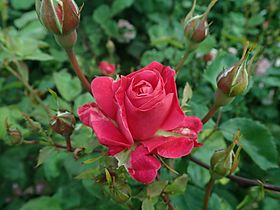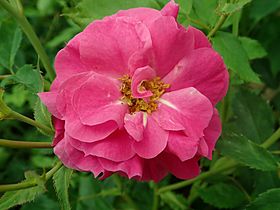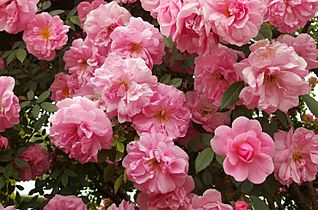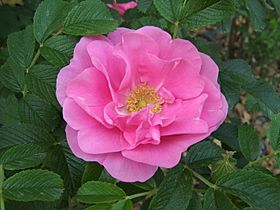Felicitas Svejda facts for kids
Quick facts for kids
Felicitas Svejda
|
|
|---|---|
| Born | November 8, 1920 |
| Died | January 19, 2016 (aged 95) |
| Education | PhD |
| Alma mater | University of Natural Resources and Life Sciences, Vienna |
| Known for | Creator of the explorer roses |
| Scientific career | |
| Fields | Genetics |
| Institutions | Central Experimental Farm, Agriculture Canada |
Felicitas Svejda (born November 8, 1920 – died January 19, 2016) was a brilliant scientist in Canada. She created special roses that could survive Canada's short summers and very cold winters.
For almost 25 years, she led the rose-breeding program. This program was at the Central Experimental Farm in Ottawa, Ontario, Canada. Today, this place is called Agriculture and Agri-Food Canada.
Dr. Svejda developed the famous Explorer Rose Series. These roses were named after brave Canadian explorers. Many of her roses also grow well in cold countries. These include Finland, Russia, Iceland, Germany, and her home country, Austria.
Contents
About Felicitas Svejda
Felicitas Svejda was born in Vienna, Austria on November 8, 1920. She loved learning about plants and farming. In 1948, she earned her Ph.D. in agricultural science. She got this degree from the University of Natural Resources and Life Sciences in Vienna.
In 1953, she moved to Canada and made her home in Ottawa, Ontario. She passed away on January 19, 2016, in Ottawa. She was 95 years old.
Her Amazing Career in Science
After finishing her studies, Dr. Svejda worked as a research assistant. She studied farm economics in Vienna from 1947 to 1951. Then, she moved to Sweden for a year. There, she worked at a place that selected seeds.
In 1953, she came to Canada. She joined the federal government's Department of Agriculture. She worked as a statistician in the cereal division. This means she worked with numbers related to grain crops.
Developing Super-Hardy Roses
In 1961, Dr. Svejda started a special project. She restarted the rose breeding program in Ottawa. Her goal was to create roses that could survive Canadian winters without protection. She also wanted them to bloom many times during the summer.
She also looked for roses that could fight off common plant diseases. These included black spot and mildew. Plus, the roses needed to look beautiful.
Back in 1961, most roses in Canada could not survive the cold. They needed special covers in winter. Only warmer areas like southern Ontario and British Columbia could grow them easily.
Dr. Svejda was very patient and determined. After eight years, she succeeded! She developed the first rose variety with all these amazing features.
The Famous Explorer Roses
The Canadian Explorer Rose series became very famous. It made the Central Experimental Farm known for its rose breeding. These roses were tough and bloomed again and again.
In 1968, Dr. Svejda started a big test. She sent her new roses and other plants all over North America. This helped her see how well they grew in different climates.
The Explorer Rose series includes 25 different types of roses. Thirteen of these were created while Dr. Svejda was working. The rest were developed by the program after she retired.
These Explorer Roses are super strong. They can handle winter, bloom many times, and resist diseases. You can find them in parks and backyards all across Canada. Some of the toughest ones even grow in Finland, Russia, Iceland, Germany, and Austria. They have even been adapted for very harsh places like the Nevada desert.
Some well-known Explorer Roses include:
- 'Alexander MacKenzie'
- 'Captain Samuel Holland'
- 'David Thompson'
- 'Jens Munk'
- 'John Cabot'
Dr. Svejda also worked on other beautiful shrubs. She developed five weigelias named after dances: Minuet, Rumba, Samba, Tango, and Polka. She also created strong forsythias called Northern Gold and Happy Centennial. And three types of mock oranges, including Buckley's Quill.
Awards and Recognition
Dr. Svejda received many awards for her important work.
- In 1985, she got a certificate of merit from the Royal National Rose Society of Great Britain.
- In 1999, she received one from the Canadian Ornamental Plant Foundation.
- She won the special Portland Gold Medal in 2004.
- In 2000, York University in Toronto gave her an honorary Doctorate of Science. This was for her amazing scientific career and contributions to growing ornamental plants.
She was also an honorary patron of the Canadian Rose Society. This means she was a special supporter of the group.
The Explorer Rose Garden
In 2005, a special garden was planted at the Central Experimental Farm in Ottawa. It was called the "Explorer Rose Garden." This garden proudly shows off the results of her research. It has both old and new types of Explorer Roses. Dr. Svejda was a special guest at the garden's opening ceremony.
In 2010, she gave her personal notes, letters, and books to the Montreal Botanical Garden Library. This collection is called "Felicitas Svejda: Scientist and rosarian" and you can find it online.
Selected Roses She Created
- 'John Cabot', (1978)
- 'Alexander MacKenzie', (1985)
- 'Captain Samuel Holland', (1991)
- 'Jens Munk', (1979)
- 'Henry Hudson', (1976)
- 'Henry Kelsey', (1984)
- 'David Thompson', (1979)
- 'John Franklin', (1979)
- 'Champlain', (1982)
- 'John Davis', (1986)
- 'J.P. Connell', (1986)
- 'William Baffin', (1983)
- 'Frontenac', (1992)
- 'Lambert Closse', (1992)
Rose Gallery






